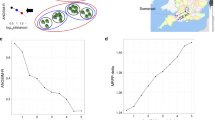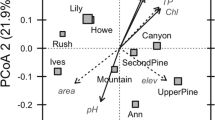Abstract
Much remains unknown about what drives microbial community structure and diversity. Highly structured environments might offer clues. For example, it may be possible to identify metabolically similar species as groups of organisms that correlate spatially with the geochemical processes they carry out. Here, we use a 16S ribosomal RNA gene survey in a lake that has chemical gradients across its depth to identify groups of spatially correlated but phylogenetically diverse organisms. Some groups had distributions across depth that aligned with the distributions of metabolic processes predicted by a biogeochemical model, suggesting that these groups performed biogeochemical functions. A single-cell genetic assay showed, however, that the groups associated with one biogeochemical process, sulfate reduction, contained only a few organisms that have the genes required to reduce sulfate. These results raise the possibility that some of these spatially correlated groups are consortia of phylogenetically diverse and metabolically different microbes that cooperate to carry out geochemical functions.
This is a preview of subscription content, access via your institution
Access options
Subscribe to this journal
Receive 12 digital issues and online access to articles
$119.00 per year
only $9.92 per issue
Buy this article
- Purchase on Springer Link
- Instant access to full article PDF
Prices may be subject to local taxes which are calculated during checkout





Similar content being viewed by others
References
Pace, N. R. A molecular view of microbial diversity and the biosphere. Science 276, 734–740 (1997).
Wilmes, P., Simmons, S. L., Denef, V. J. & Banfield, J. F. The dynamic genetic repertoire of microbial communities. FEMS Microbiol. Rev. 33, 109–132 (2009).
Rundell, E. A. et al. 16S rRNA gene survey of microbial communities in winogradsky columns. PLoS ONE 9, e104134 (2014).
Ward, D. M., Ferris, M. J., Nold, S. C. & Bateson, M. M. A natural view of microbial biodiversity within hot spring cyanobacterial mat communities. Microbiol. Mol. Biol. Rev. 62, 1353–1370 (1998).
Bier, R. L., Voss, K. A. & Bernhardt, E. S. Bacterial community responses to a gradient of alkaline mountaintop mine drainage in Central Appalachian streams. ISME J. 9, 1378–1390 (2015).
Schrenk, M. O., Kelley, D. S., Delaney, J. R. & Baross, J. A. Incidence and diversity of microorganisms within the walls of an active deep-sea sulfide chimney. Appl. Environ. Microbiol. 69, 3580–3592 (2003).
Pinel-Alloul, B. & Ghadouani, A. in The Spatial Distribution of Microbes in the Environment (eds Franklin, R. B. & Mills, A. L. ) 203–310 (Springer, 2007).
Neufeld, J. D., Wagner, M. & Murrell, J. C. Who eats what, where and when? Isotope-labelling experiments are coming of age. ISME J. 1, 103–110 (2007).
Albertsen, M. et al. Genome sequences of rare, uncultured bacteria obtained by differential coverage binning of multiple metagenomes. Nature Biotechnol. 31, 533–538 (2013).
Martiny, A. C., Treseder, K. & Pusch, G. Phylogenetic conservatism of functional traits in microorganisms. ISME J. 7, 830–838 (2013).
Klein, M. et al. Multiple lateral transfers of dissimilatory sulfite reductase genes between major lineages of sulfate-reducing prokaryotes. J. Bacteriol. 183, 6028–6035 (2001).
Orphan, V. J. et al. Comparative analysis of methane-oxidizing archaea and sulfate-reducing bacteria in anoxic marine sediments. Appl. Environ. Microbiol. 67, 1922–1934 (2001).
Madigan, M. T., Martinko, J. M., Dunlap, P. V. & Clark, D. P. Brock Biology of Microorganisms 12th edn (Pearson/Benjamin Cummings, 2009).
Varadharajan, C. Magnitude and Spatio-temporal Variability of Methane Emissions from a Eutrophic Freshwater Lake PhD thesis, Massachusetts Institute of Technology (2009).
Varadharajan, C. & Hemond, H. F. Time-series analysis of high-resolution ebullition fluxes from a stratified, freshwater lake. J. Geophys. Res. Biogeosci. 117 G02004 (2012).
Senn, D. B. Coupled Arsenic, Iron, and Nitrogen Cycling in Arsenic-Contaminated Upper Mystic Lake PhD thesis, Massachusetts Institute of Technology (2001).
Senn, D. B. & Hemond, H. F. Nitrate controls on iron and arsenic in an urban lake. Science 296, 2373–2376 (2002).
Peterson, E. J. R. Carbon and Electron Flow via Methanogenesis, SO 42−, NO 3− and Fe3+ Reduction in the Anoxic Hypolimnia of Upper Mystic Lake Masters thesis, Massachusetts Institute of Technology (2005).
Wetzel, R. G. Limnology 3rd edn (Academic, 2001).
Preheim, S. P., Perrotta, A. R., Martin-Platero, A. M., Gupta, A. & Alm, E. J. Distribution-based clustering: using ecology to refine the operational taxonomic unit. Appl. Environ. Microbiol. 79, 6593–6603 (2013).
Jax, K. Ecological units: definitions and application. Q. Rev. Biol. 81, 237–258 (2006).
Hunter, K. S., Wang, Y. F. & Van Cappellen, P. Kinetic modeling of microbially-driven redox chemistry of subsurface environments: coupling transport, microbial metabolism and geochemistry. J. Hydrol. 209, 53–80 (1998).
Thomas, F., Hehemann, J.-H., Rebuffet, E., Czjzek, M. & Michel, G. Environmental and gut Bacteroidetes: the food connection. Front. Microbiol. 2, 93 (2011).
Holmes, D. E., Nevin, K. P., Woodard, T. L., Peacock, A. D. & Lovley, D. R. Prolixibacter bellariivorans gen. nov., sp. nov., a sugar-fermenting, psychrotolerant anaerobe of the phylum Bacteroidetes, isolated from a marine-sediment fuel cell. Int. J. Syst. Evol. Microbiol. 57, 701–707 (2007).
Leloup, J., Quillet, L., Oger, C., Boust, D. & Petit, F. Molecular quantification of sulfate-reducing microorganisms (carrying dsrAB genes) by competitive PCR in estuarine sediments. FEMS Microbiol. Ecol. 47, 207–214 (2004).
Spencer, S. J. et al. Massively parallel sequencing of single cells by epicPCR links functional genes with phylogenetic markers. ISME J. 10, 427–436 (2016).
Purkhold, U., Wagner, M., Timmermann, G., Pommerening-Roser, A. & Koops, H. P. 16S rRNA and amoA-based phylogeny of 12 novel betaproteobacterial ammonia-oxidizing isolates: extension of the dataset and proposal of a new lineage within the nitrosomonads. Int. J. Syst. Evol. Microbiol. 53, 1485–1494 (2003).
Alawi, M., Lipski, A., Sanders, T., Pfeiffer, E.-M. & Spieck, E. Cultivation of a novel cold-adapted nitrite oxidizing betaproteobacterium from the Siberian Arctic. ISME J. 1, 256–264 (2007).
Canfield, D. E., Kristensen, E. & Thamdrup, B. in Advances in Marine Biology Vol. 48 (eds Canfield, D. E., Kristensen, E. & Thamdrup, B. ) 205–267 (Academic, 2005).
Costa, E., Perez, J. & Kreft, J. U. Why is metabolic labour divided in nitrification? Trends Microbiol. 14, 213–219 (2006).
Beck, D. A. C. et al. A metagenomic insight into freshwater methane-utilizing communities and evidence for cooperation between the Methylococcaceae and the Methylophilaceae. PeerJ. 1, e23 (2013).
Faust, K. & Raes, J. Microbial interactions: from networks to models. Nature Rev. Microbiol. 10, 538–550 (2012).
Eiler, A., Heinrich, F. & Bertilsson, S. Coherent dynamics and association networks among lake bacterioplankton taxa. ISME J. 6, 330–342 (2012).
Gies, E. A., Konwar, K. M., Beatty, J. T. & Hallam, S. J. Illuminating microbial dark matter in meromictic Sakinaw Lake. Appl. Environ. Microbiol. 80, 6807–6818 (2014).
Koenig, J. E. et al. Succession of microbial consortia in the developing infant gut microbiome. Proc. Natl Acad. Sci. USA 108, 4578–4585 (2011).
Horner-Devine, M. C. et al. A comparison of taxon co-occurrence patterns for macro- and microorganisms. Ecology 88, 1345–1353 (2007).
Radajewski, S., Ineson, P., Parekh, N. R. & Murrell, J. C. Stable-isotope probing as a tool in microbial ecology. Nature 403, 646–649 (2000).
Dekas, A. E. & Orphan, V. J. Identification of diazotrophic microorganisms in marine sediment via fluorescence in situ hybridization coupled to nanoscale secondary ion mass spectrometry (FISH-NanoSIMS). Methods Enzymol. 486, 281–305 (2011).
Nielsen, J. L. & Nielsen, P. H. Handbook of Hydrocarbon and Lipid Microbiology (ed. Timmis, K. N. ) (Springer-Verlag, 2010).
Stookey, L. L. Ferrozine—a new spectrophotometric reagent for iron. Anal. Chem. 42, 779–781 (1970).
Blackburn, M. C. Development of New Tools and Applications for High-Throughput Sequencing of Microbiomes in Environmental or Clinical Samples Masters thesis, Massachusetts Institute of Technology (2010).
Lane, D. J. in Nucleic Acid Techniques in Bacterial Systematics (eds Stackebrandt, E. & Goodfellow, M. ) 125–175 (Wiley, 1991).
Edgar, R. C. UPARSE: highly accurate OTU sequences from microbial amplicon reads. Nature Methods 10, 996–998 (2013).
Quast, C. et al. The SILVA ribosomal RNA gene database project: improved data processing and web-based tools. Nucleic Acids Res. 41, D590–D596 (2013).
Schloss, P. D. et al. Introducing mothur: open-source, platform-independent, community-supported software for describing and comparing microbial communities. Appl. Environ. Microbiol. 75, 7537–7541 (2009).
Edgar, R. C., Haas, B. J., Clemente, J. C., Quince, C. & Knight, R. UCHIME improves sensitivity and speed of chimera detection. Bioinformatics 27, 2194–21200 (2011).
Wang, Q., Garrity, G. M., Tiedje, J. M. & Cole, J. R. Naive Bayesian classifier for rapid assignment of rRNA sequences into the new bacterial taxonomy. Appl. Environ. Microbiol. 73, 5261–5267 (2007).
Guindon, S. et al. New algorithms and methods to estimate maximum-likelihood phylogenies: assessing the performance of PhyML 3.0. Syst. Biol. 59, 307–321 (2010).
Altschul, S. F., Gish, W., Miller, W., Myers, E. W. & Lipman, D. J. Basic local alignment search tool. J. Mol. Biol. 215, 403–410 (1990).
Tamminen, M. V. & Virta, M. P. J. Single gene-based distinction of individual microbial genomes from a mixed population of microbial cells. Front. Microbiol. 6, 195 (2015).
Turchaninova, M. A. et al. Pairing of T-cell receptor chains via emulsion PCR. Eur. J. Immunol. 43, 2507–2515 (2013).
Wagner, M. et al. Functional marker genes for identification of sulfate-reducing prokaryotes. Methods Enzymol. 397, 469–489 (2005).
Wagner, M., Roger, A. J., Flax, J. L., Brusseau, G. A. & Stahl, D. A. Phylogeny of dissimilatory sulfite reductases supports an early origin of sulfate respiration. J. Bacteriol. 180, 2975–2982 (1998).
Acknowledgements
This material is based on work supported by the National Science Foundation Graduate Research Fellowship (grant no. 1122374) and by the US Department of Energy, Office of Science, Office of Biological and Environmental Research (award no. DE-SC0008743).
Author information
Authors and Affiliations
Contributions
S.P.P., S.W.O., H.H. and E.J.A. designed the research. S.P.P., S.W.O., A.M., C.V., M.B. and S.J.S. performed the research. S.P.P., S.W.O., J.F. and J.R. contributed analytical tools. S.P.P., S.W.O. and J.R. analysed the data. S.P.P., S.W.O. and E.J.A. wrote the paper.
Corresponding author
Ethics declarations
Competing interests
The authors declare no competing financial interests.
Supplementary information
Supplementary information
Supplementary Text, Supplementary References, Supplementary Tables 1–6, Supplementary Figures 1–9 (PDF 2565 kb)
Rights and permissions
About this article
Cite this article
Preheim, S., Olesen, S., Spencer, S. et al. Surveys, simulation and single-cell assays relate function and phylogeny in a lake ecosystem. Nat Microbiol 1, 16130 (2016). https://doi.org/10.1038/nmicrobiol.2016.130
Received:
Accepted:
Published:
DOI: https://doi.org/10.1038/nmicrobiol.2016.130
This article is cited by
-
Bacterial community composition and functional potential associated with a variety of urban stormwater sources
Urban Ecosystems (2021)
-
Redox-informed models of global biogeochemical cycles
Nature Communications (2020)
-
Genomic comparison of Clostridium species with the potential of utilizing red algal biomass for biobutanol production
Biotechnology for Biofuels (2018)
-
Dynamics of microbial populations mediating biogeochemical cycling in a freshwater lake
Microbiome (2018)



